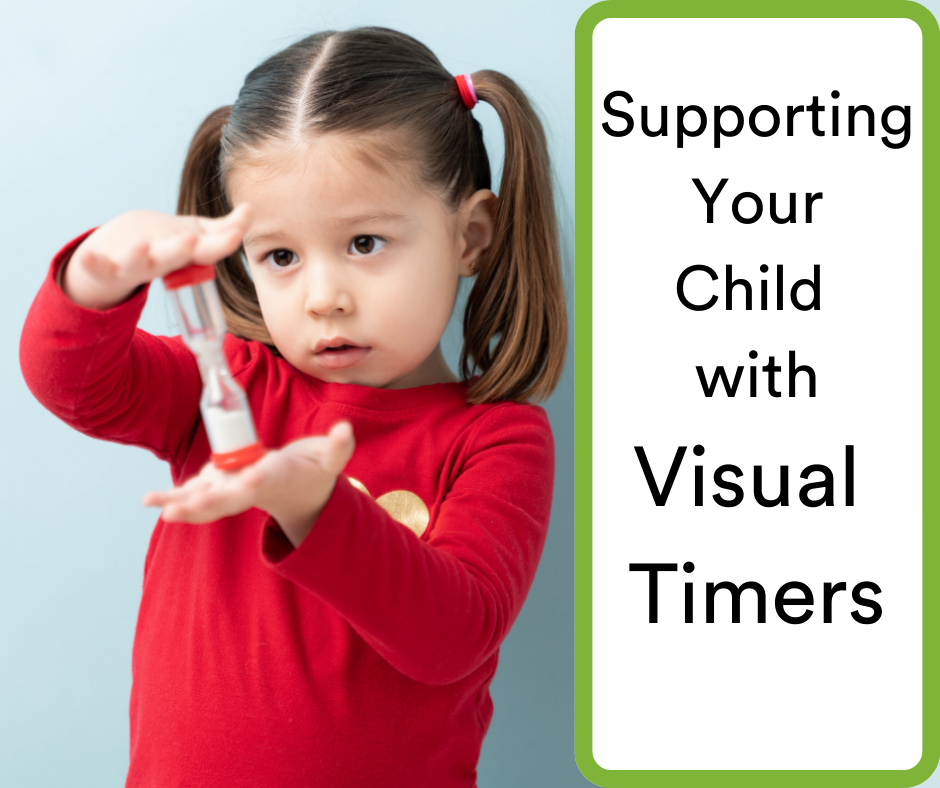
By Ashleigh Evans, MS, BCBA
Time is a challenging concept for children to grasp. It is even more difficult for concrete thinkers, as many neurodiverse children are. Children with autism tend to understand concrete concepts better than abstract ones, like time. Visual timers and other supports can help bridge the gap, giving children a better understanding of time.
What is a visual timer?
Visual timers allow you to observe the passage of time through visual cues. There are different types of visual timers. The type you choose will depend on a number of factors, such as your child’s preference and your intended use of the timer.
Here are a few options
The Time Timer demonstrates the passage of time with a colored disk that fades away as time passes. With this timer, your child can easily observe the color closing in as the time passes.
Time Timers are great for longer activities, as you can set them for up to one hour.
Sand timers are another great option to demonstrate the passage of time. Each sand timer has a different duration. They come in durations of 1 minute, 2 minutes, 5 minutes, and 10 minutes. Simply flip it over and watch the sand flow down. When the minutes are up, the sand will be entirely at the bottom.
The Time Tracker is a unique and customizable visual timer. The green, yellow, and red sections light up to serve as warnings for the amount of time left for an activity. You can program the time each section lights up, making it customizable to your needs.
How can visual timers be used at home?
Visual timers are great for helping with transitions, whether big or small.
Here are a few ideas for using visual timers with your child at home
- To show the remaining time in an activity. Transitioning away from a favorite activity like screen time or playing outside can cause distress for many children. A visual timer can make these transitions easier by providing a visual cue before the activity is over.
- To help your child wait for an upcoming activity. Waiting is not easy. For children with a limited understanding of time, being told to wait may feel the same as being told “no.” To help your child understand what “wait” means, set your visual timer to allow them to observe the amount of time they need to wait.
- For morning and bedtime routines. A Time Timer with a dry-erase board can be beneficial to help your child work through morning, bedtime, or any other routines. Set the timer for each task and check each off as you go through the routine.
- To teach your child how long to engage in an activity. If your child tends to rush through activities they should be spending more time on, set a visual timer to help them identify how long to spend in that activity. Brushing teeth, for example, is a daily task that many children tend to rush through. A visual timer is a great way to help them learn how long to spend brushing.
Review the visual timer with your child and set expectations before using it. This will help things run more smoothly when you begin using it. Don’t worry if it doesn’t click right away. It may take time for your child to understand how the visual relates to the activity. With consistency, your child should be able to understand the concept of time better.
About the Author
Ashleigh Evans, MS, is a Board Certified Behavior Analyst. She has been practicing in the behavior analysis field for over 13 years and opened her own independent practice in early 2022. Her experience has been vast across different age groups, diagnoses, and needs. She is passionate about improving the field through education, reformative action, and better supervisory practices, leading her to create content and resources for families and ABA professionals which can be found on her website, www.evansbehavioralservices.com/.
